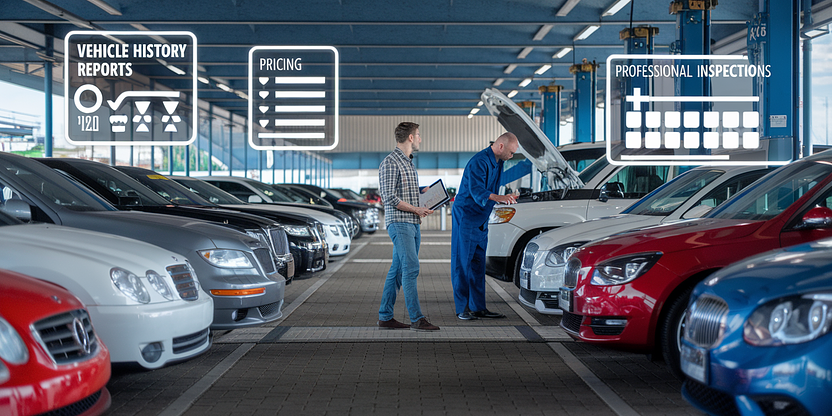
Used Car Checklist: Inspection, Mileage, History (2025)
Introduction
Buying a used car in 2025 can be a smart decision if done correctly. With the right information and a thorough evaluation, you can ensure that you're investing in a reliable vehicle that meets your needs. This guide offers a comprehensive look into what to inspect, how to evaluate mileage, and the importance of vehicle history. We will equip you with a complete checklist to use when evaluating any used car.
The Complete Checklist
[ ] Exterior Inspection
Why This Matters:
The car's exterior condition can indicate how well it has been maintained and highlight potential issues.
What To Look For:
- Paint finish consistency
- Signs of rust or damage
- Condition of lights and mirrors
Recommended Products:
Budget Option: Hyundai Accent ($12,000)
Economical choice, minor cosmetic wear.
Best Value: Honda Civic ($18,000)
Durable with consistent exterior, minor scuffs.
Premium: Lexus ES ($30,000)
Excellent exterior, minimal signs of wear.
Common Mistake:
Neglecting rust spots which could cost more in repairs over time. Always inspect wheel wells and underbody for rust.
[ ] Interior Inspection
Why This Matters:
Interior condition affects comfort and indicates overall vehicle care.
What To Look For:
- Upholstery condition
- Dashboard functionality
- Odors or stains
Recommended Products:
Budget Option: Ford Focus ($11,000)
Simple interior with minor wear.
Best Value: Mazda 3 ($17,500)
Well-maintained, clean interiors.
Premium: BMW 3 Series ($28,000)
Luxury interior with high-end finishes.
Common Mistake:
Underestimating lingering odors or stains which may be costly to fix. Test all dashboard electronics.
[ ] Mechanical Inspection
Why This Matters:
Mechanical integrity ensures the car runs smoothly and safely.
What To Look For:
- Engine condition
- Brake system functionality
- Suspension assessment
Recommended Products:
Budget Option: Toyota Corolla ($10,500)
Reliable engine, moderate mileage.
Best Value: Subaru Outback ($18,500)
Solid mechanical condition, comprehensive history.
Premium: Audi A4 ($32,000)
Superior engineering, low mileage.
Common Mistake:
Ignoring minor engine noises or brake issues, which can lead to larger, costly problems.
[ ] Mileage Verification
Why This Matters:
Mileage affects vehicle value and hints at remaining lifespan.
What To Look For:
- Consistency with car age
- Wear consistent with odometer
- Service records validation
Recommended Products:
Budget Option: Kia Rio ($9,500)
Higher mileage, strong reputation.
Best Value: Nissan Leaf ($19,000)
Moderate mileage, great efficiency.
Premium: Tesla Model 3 ($40,000)
Low mileage, advanced technology.
Common Mistake:
Failing to compare mileage against car age and service history. Look for service records.
[ ] Vehicle History Report
Why This Matters:
A vehicle’s past affects its future reliability and safety.
What To Look For:
- Accident history
- Service maintenance records
- Title status (e.g., salvage, clean)
Recommended Products:
Budget Option: Chevrolet Malibu ($11,500)
Clean title, few repairs.
Best Value: Honda Accord ($20,000)
Comprehensive maintenance history.
Premium: Mercedes-Benz C-Class ($35,000)
Detailed service records, minimal past issues.
Common Mistake:
Overlooking changes in title status and incomplete records. Always obtain a detailed history report.
Budget Summary
Option Exterior Interior Mechanical Mileage History Budget Accent $12,000 Focus $11,000 Corolla $10,500 Rio $9,500 Malibu $11,500 Value Civic $18,000 Mazda 3 $17,500 Outback $18,500 Leaf $19,000 Accord $20,000 Premium Lexus ES $30,000 BMW 3 Series $28,000 Audi A4 $32,000 Tesla Model 3 $40,000 C-Class $35,000FAQ
Q1: What mileage is considered too high for a used car?
A1: Mileage over 100,000 may indicate a vehicle’s nearing its lifespan, but it also depends on maintenance records.
Q2: How can I verify the accuracy of a car's mileage?
A2: Cross-reference the odometer with service records and vehicle history reports for discrepancies.
Q3: Is it necessary to get a mechanic’s inspection for a used car?
A3: Absolutely, a mechanical inspection can uncover hidden issues that might not be immediately apparent.
Q4: What should I consider if a car has been in a minor accident?
A4: Ensure repairs were done professionally and check if it affects the car's warranty or resale value.
Q5: How can vehicle history affect my buying decision?
A5: A comprehensive history report can reveal past issues that could impact future reliability and value.
Final Checklist (Quick Reference)
- [ ] Exterior Inspection
- [ ] Interior Inspection
- [ ] Mechanical Inspection
- [ ] Mileage Verification
- [ ] Vehicle History Report
 Checklist Method
Checklist Method



